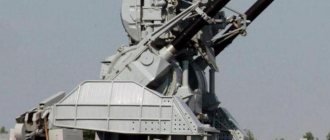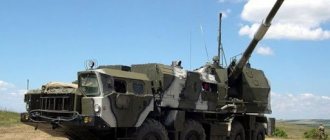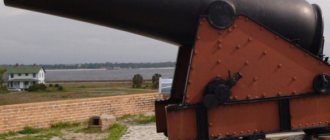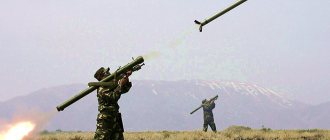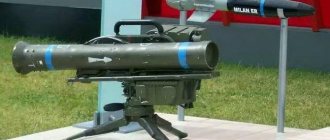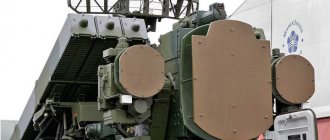The evolution of armor and tactics meant that the heavy sword of the knightly cavalry became less effective. Gradually, the sword became shorter and narrower, this was required so that it could not break through armor, but cut and stab joints. In addition, the sword became too heavy for cutting through infantry formations in close formation; a lighter, but at the same time agile weapon was required.
This is how the cavalry broadsword appeared on the scene, a further development of the knight's sword. A heavy straight or slightly curved blade, with one-sided or one-and-a-half sharpening, about a meter long, which was convenient for operating in a closed equestrian formation. The broadsword, a weapon of heavy cavalry, appeared in the late Middle Ages and left the scene only at the beginning of the twentieth century. Moreover, these blades are still the ceremonial and ceremonial weapons of a number of states.
The birth of the broadsword and service on land
During the late Middle Ages, many types of weapons and armor evolved. Armor became more complex and stronger; bows and crossbows were replaced by muskets and arquebuses. Combat tactics also became more complex.
The attacks of the heavy armored cavalry were opposed by closed ranks of infantry armed with pikes and halberds. Firearms appeared in the ranks. Horsemen needed weapons that were lighter and more controllable than swords and pikes.
The term broadsword is associated with the Turks. It is not for nothing that it is believed that its ancestor was the konchar, a long and narrow Eastern European sword that could have come from the Caucasus. Translated "PALA" means dagger.
But it is incorrect to compare it and the scimitar - the weapon of the Turkish Janissaries. The scimitar was created as a type of knife, a response to the demands of the sultans not to carry weapons in peacetime.
The broadsword is a continuation of the evolution of the sword.
It is necessary to distinguish between earlier eastern blades, which were narrow swords with a simple crosshair and an inclined hilt for ease of cutting, and later Western European broadswords with a closed basket guard.
The appearance of the first examples of broadswords in Western Europe dates back to the 16th century; they appeared in the arsenal of the Hungarian hussars. Unlike the later hussars, this was armored cavalry, considered at that time the best in Europe.
Next came mercenary reiters from the German principalities, and later dragoons. Their weapons consisted of a broadsword and a pair of saddle pistols, from which they fired before attacking on horseback.
It must be taken into account that a broadsword, unlike a sword, allowed the use of not only direct chopping blows, but also more cunning feints and thrusts, in addition, the technique of fencing with a broadsword takes one hand, the second hand remained free, often it contained a daga - a dagger for the left hand or a pistol .
In addition to the Caucasus, similar blades also appeared in Britain; among the Scots, traditional claymore swords began to be replaced by a shorter and narrower sword with a crosshair and a basket covering the hand.
The Scottish broadsword was lighter than a sword, better protected the warrior’s hand due to a more developed guard, and made it possible to use a “fist” round shield, while claymores, for the most part, were two-handed weapons.
These weapons came to Russia en masse under Peter I as the weapons of dragoons and cuirassiers. As a rule, these are custom-made blades from Solingen (Germany), but a small percentage were also forged by Russian craftsmen.
At the same time, the broadsword entered service with some dragoon regiments. In pre-Petrine times, broadswords were also known in Rus' as weapons of foreign mercenary officers from regiments of the new system. However, one of the most famous examples of this type of weapon belonged to Skopin-Shuisky, the famous commander of the Time of Troubles.
In the 19th century, broadswords gradually gave way to lighter sabers, but still remained in service with heavy cavalry - cuirassier regiments and horse guards carried them as their main weapon until the start of the First World War. It was after it began that they gave way to lighter cavalry sabers and checkers.
Anti-aircraft missile and artillery complex "Broadsword"/"Palma"
The start of testing of the lead frigate of Project 22350 “Admiral of the Fleet of the Soviet Union Gorshkov” is planned for 2014. This ship is equipped with powerful missile and artillery weapons for various purposes. Of particular interest is the new anti-aircraft system installed on the new frigate. To protect the ship from enemy missiles and aircraft in the near zone, Project 22350 frigates must receive the new 3M89 Broadsword anti-aircraft missile and artillery system (ZRAK).
ZRAK "Broadsword" on the R-60 missile boat (https://forums.airbase.ru)
Despite the fact that the ZRAK 3M89 “Broadsword” was created in the early nineties, to date it has not received much distribution. According to available data, the Russian Navy has only a few complexes of this model. In particular, one of them is installed on the R-60 missile boat of the Black Sea Fleet. The construction of new frigates of Project 22350 will significantly increase the number of used anti-aircraft systems of the new model.
The first mention of a new anti-aircraft missile and artillery system developed at the Precision Engineering Design Bureau named after. A.E. Nudelman, appeared in the mid-nineties. ZRAK "Broadsword" was developed as a less complex alternative to the "Kortik" complex of the Tula Instrument Engineering Design Bureau that already existed at that time.
In the first half of the last decade, an experimental combat module 3Р89 was assembled, designated A-289. The module was tested at the test site and then installed on the R-60 missile boat. The "Broadsword" air defense system installed on the boat was tested until 2007. At the end of the same year, the new anti-aircraft system was put into trial operation, where it is still in use.
The Broadsword anti-aircraft missile and artillery system is intended to create a continuous air defense zone for a ship or boat at a range of up to 10 kilometers. To destroy targets, the Broadsword air defense missile system has two artillery guns and a set of guided missiles. This makes it possible to create a layered destruction zone and thereby increase the likelihood of successful target destruction: an object that breaks through the missiles’ zone of responsibility will be destroyed by artillery guns.
Damage zones of air defense systems with Sosna-R missiles (from the website of KB Tochmash, 2008)
The 3Р89 ZRAK "Broadsword" combat module combines several different systems, which allows it to be installed on any suitable ship with a displacement of more than 500 tons. The combat module includes a main unit that houses part of the equipment. Guidance equipment is installed on the upper surface of the main unit. On the side surfaces there are mechanisms for attaching guns and missiles.
Combat module 3Р89 ZRAK "Broadsword" with ammunition and 9M337 missile defense system (3D model, author - Allocer, https://allocer.nxt.ru/models/military/palash/palash.htm)
3D model and projections of the combat module 3Р89 ZRAK 3М89 “Broadsword” (author - Allocer, https://allocer.nxt.ru/models/military/palash/palash.htm)
To destroy targets at ranges up to 4000 meters and at altitudes up to 3000 m, the Broadsword complex can use two AO-18KD anti-aircraft guns. Six-barrel 30 mm caliber guns have a firing rate of up to 5 thousand rounds per minute (total - 10 thousand rounds per minute). According to available data, the ZRAK "Broadsword" anti-aircraft guns use two types of projectiles. High-explosive fragmentation shells have an initial speed of up to 940 m/s and are capable of destroying targets with an explosion and fragments. Armor-piercing sabot shells leave the barrel at speeds of up to 1100 m/s. The artillery part of the anti-aircraft complex is equipped with a linkless auger ammunition supply system. The combat module stores can accommodate up to 1,500 shells.
It is proposed to destroy targets outside the cannon firing radius using 9M337 Sosna-R missiles. Up to eight transport and launch containers with these ammunition can be installed on the ZRAK “Broadsword” combat module. The guided missile with a launch weight of about 30 kg is made according to a two-stage design. When leaving the transport and launch container, the rocket uses a jettisonable booster engine of the first stage; after separation, the flight is carried out using the propulsion system of the sustainer stage. The maximum speed of the 9M337 rocket is stated at 875 m/s. The maximum destruction range is 10 km, the maximum height is 5 km.
SAM 9M337 (photo by Said Aminov, https://pvo.guns.ru)
The Sosna-R anti-aircraft missile has an original control system. During the initial phase of the flight, the missile is aimed at the target according to commands from the anti-aircraft complex received via a radio channel. After the missile reaches the line of sight, control is carried out using a protected laser command system. This control system and high maneuverability of the missile are said to significantly increase its combat capabilities. The missile carries a rod warhead weighing about 5 kg.
To search and track targets, the 3M89 Broadsword ZRAK can use external guidance from shipborne radar systems. In addition, there is its own optical-electronic control station “Ball”, located on the upper surface of the combat module. Under the characteristic spherical casing there are television and thermal imaging equipment, a laser rangefinder, as well as an antenna and a missile guidance laser.
Module OESU "Ball" ZRAK "Broadsword" (2005, version, photo from the Warman archive, https://militaryrussia.ru/forum)
Antennas of interrogators of the state identification system “friend or foe” (lattice) and an optical sighting column on the R-60 missile boat before installing the combat module ZRAK “Broadsword”, Shipyard No. 13, Sevastopol, autumn 2005 (photo from the Warman archive, https:/ /militaryrussia.ru/forum)
The capabilities of the “Shar” station allow you to engage an “aircraft” type target for automatic tracking at ranges of up to 30 km (depending on the characteristics of the target). For cruise missiles, the maximum capture range is 10-12 kilometers.
The Shar optical-electronic control station is interfaced with a digital computer and other components of the complex. All information about the operation of the systems is displayed on the control panel monitor. Depending on the environment, the Broadsword ZRAK can operate in fully automatic or semi-automatic mode. In the latter case, part of the control operations is carried out by the operator of the complex using automation.
RAC "Broadsword", tests on the R-60 missile boat, 2006-2007. (photo from the Warman archive, https://militaryrussia.ru/forum)
The missile control systems are protected from interference. The command equipment produces a relatively narrow control beam, which makes it much more difficult to suppress. In addition, the use of a laser control system at the final stage of the flight almost completely eliminates any jamming of the control signal.
The 3M89 "Broadsword" anti-aircraft missile and artillery system is capable of implementing layered air defense of the base ship. Thus, at ranges from 1.3 to 10 kilometers, target destruction is carried out using Sosna-R missiles. Aimed fire from automatic cannons can be fired at a range from 200 to 4000 meters. 9M337 missiles are capable of destroying targets flying at speeds of up to 700 m/s. The maximum target speed that the guns can hit is 300 m/s. The reaction time of the complex does not exceed 5-7 seconds.
ZRAK "Broadsword" is intended for use on ships of the Russian Navy. A version of the complex called 3M89E “Palma” has been developed for supplies to foreign customers. According to available data, foreign buyers have a choice of several options for the Palma system. Depending on its needs, the customer can purchase a fully equipped anti-aircraft system, a combat module without surveillance systems, as well as a module with only missile or only artillery weapons.
In 2011, two Russian-made Project 11661E Gepard-3.9 patrol ships were accepted into the Vietnamese naval forces. At the request of the customer, these ships each received one Palma combat module with missile and artillery weapons. Last year, construction began on two new ships of the same type for the Vietnamese Navy. They should receive the same weapons as the first two patrol boats.
It is also known that one combat module “Broadsword” was installed on the patrol boat “Dagestan” of Project 11661. Thus, the domestic navy currently has only two copies of the “Broadsword” air defense missile system: on the missile boat R-60 (an experienced combat module) and on the patrol boat "Dagestan".
Currently, the Broadsword anti-aircraft missile and artillery system is the newest system of its class, adopted by the Russian Navy and installed on ships. In the future, it may be replaced by the Pantsir-M shipborne air defense system, the basis for which was the Pantsir-S1 land-based complex. In the meantime, the construction of Project 22350 frigates, which are equipped with the 3M89 Broadsword anti-aircraft system, continues.
Based on materials from the sites: https://rbase.new-factoria.ru/ https://kbtochmash.ru/ https://bastion-karpenko.narod.ru/ https://militaryrussia.ru/blog/topic-15. html
Naval broadsword
In addition to arming cavalry, broadswords performed well at sea. During the boarding battles for which the Renaissance was famous. It was the boarding sword that earned universal respect and became part of the ceremonial uniform of sailors in many countries.
Including Russia, the naval broadsword was part of the ceremonial uniform of the Imperial Navy of the Russian Empire, and later passed into the USSR Navy, the last mention of naval broadswords dates back to 1940, then they were the statutory weapons of cadets of naval schools.
The naval broadswords did not spare Great Britain and Germany either. It was these heavy straight blades that were part of the dress uniform of naval officers.
These blades take their history from the hot boarding battles of the 16th and 17th centuries; in those days, broadswords combined the functions of an ax and a saber. Convenient for use in narrow and cramped spaces of cabins and decks, they can stab and chop, the weight of the blade enhances the blow, and the blade inflicts terrible wounds.
The modern version of this weapon is the naval broadsword; the officer's broadsword originates precisely from the blood-soaked decks of ships of the late 17th century. The boarding broadsword also had its own varieties; a blade with a shell-shaped guard was called a scallop.
Broadswords in service with the Russian army
From top to bottom: broadsword of private heavy cavalry model 1821 (Austria); cuirassier officer's broadsword of the French type (Prussia, second half of the 19th century); dragoon broadsword model 1815 (Baden, Germany); cuirassier broadsword model 1819 (Prussia); broadsword of private line cavalry (France). The handle of broadswords is most often placed slightly at an angle to the blade, which makes them more convenient for cutting from a horse. The hilts were equipped with guards and several protective arches - front and side. The side arches were located on the outside of the hilt and were often very impressive, intricate weaves, sometimes decorated with some kind of heraldic figures.
The regular cavalry created in Russia in the 18th century was also armed with broadswords. Already since 1700, they, along with swords, sabers, etc., were found among dragoons. In 1711, with the streamlining of dragoon weapons, broadswords became their mandatory attribute. Officers' broadswords differed from soldiers' broadswords only in their gilded hilt.
From top to bottom: cuirassier officer's broadsword, model 1826 (Zlatoust, 1833); cuirassier officer's broadsword model 1826 (Solingen); cuirassier officer's broadsword, model 1810
In the second half of the 18th century, the blades of Russian broadswords were both double-edged and single-edged, and from the first decade of the 19th century only single-edged ones were used.
Broadswords of the 18th century had leather or wooden sheaths covered with leather, as well as a metal device (mouth, nuts with rings for sword belts, tip), simple or slotted, covering almost the entire surface of the sheath.
During the same period as in Russia, in the 18th - early 19th centuries, there was a gradual unification of broadswords in the cavalry of European armies; uniform models were introduced both for regiments and for each type of cavalry: dragoon broadswords, cuirassier broadswords, etc.
After the division of the Russian cavalry into light (hussars, lancers), medium (dragoons) and heavy (cuirassiers), broadswords became the privilege of the latter.
Lancers, dragoons and cuirassiers of the Russian army
Cuirassiers got their name from the cuirass - a steel shell worn on the chest and later on the back of the rider.
Heavy cavalry appeared in the Russian army in 1731, and cuirassiers immediately received broadswords.
Dragoons could at different times arm themselves with swords, broadswords or sabers, but heavy cavalry always remained faithful to broadswords.
Since the 1700s, the following types of broadswords have been in service with the Russian regular cavalry:
| Dragoon broadsword | officer | 1700s |
| Dragoon broadsword | officer | 1720s |
| Dragoon broadsword | soldier's | 1750s 2 options |
| Cuirassier broadsword | 1740s | |
| Broadsword of the Life Guards Cavalry Regiment | soldier's | 1763 |
| Cuirassier broadsword | 1760 | |
| Carabinieri broadsword | soldier's | 1763 |
| Broadsword of the Life Guards Cavalry Regiment | second half of the 1790s | |
| Dragoon broadsword | soldier and officer | 1798 |
| Army cuirassier broadsword | soldier and officer | 1798 |
| Cavalry broadsword | 1799 | |
| Cavalry broadsword | 1799 for wearing in uniform | |
| Cavalry broadsword | 1802 | |
| Horse artillery broadsword | lower ranks | 1803 |
| Dragoon broadsword | soldier and officer | 1806 |
| Cuirassier broadsword | soldier and officer | 1810 |
| Cuirassier broadsword | soldier and officer | 1826 |
| Sailor's boarding broadsword | 1856 |
In the field, due to combat expediency, the cuirassiers-guards acted as dragoons, but in parades and on guard until 1917 they wore both cuirasses and broadswords.
In the first of these regiments - the Life Guards Cavalry Guard of Her Majesty Maria Fedorovna - there was even a kind of cult of the broadsword. Edged weapons in Rus' were called white weapons. For the same reason, the cavalry guards called their broadsword the “white lady.” Their regimental march was taken from the French opera The White Lady. The regiment even had its own ghost, which appeared on the eve of major troubles, and this ghost, of course, was also the White Lady.
Cuirassier officer's broadswords, model 1810, Zlatoust, masters V. and L. Shafa (?). 1820s
At the beginning of the 19th century, the blades of broadswords, still quite powerful and wide, became more elegant. If at first the broadsword was primarily a cutting weapon, now its main purpose is a sharp thrust that knocks the rider out of the saddle, or inflicts a puncture wound on the enemy. In this regard, in the 19th century, broadsword blades acquired a tapering point instead of a rounded one.
catalogCatalog of edged weaponsBayonets, knives, daggers (photo, technical characteristics)
The last two models lasted until 1917. If we talk about the naval boarding broadsword, then in the naval schools of the USSR, senior students sported it until 1956.
Broadsword of cadets of the naval schools of the USSR (1940)
Nowadays, broadswords are worn by the honorary guards of a number of European countries that have historical uniforms. In Sweden these are the royal drabants, in Great Britain they are the regiments of Her Majesty's Horse Guards. There is a similar tradition in France, which, being a republic, has preserved its historical roots, and in many other states.
permitsRegistration of weapons (obtaining permits)
saleHow to sell your weapon
storageWho and how often can check the storage conditions of weapons
morePurchase of cartridges, gunpowder, bullets, etc.
licensesPurchase of edged weapons
What does a broadsword consist of?
This is a cutting and piercing weapon with a straight blade. Like other bladed weapons, a broadsword consists of a blade and a hilt. The blade has a slight bend or is absolutely straight, tapering towards the tip, and may have 1-3 lobes. Sharpening is most often on one side, but one-and-a-half and less often double-sided sharpening was also found.
The scabbard had a different type and structure, from leather (with metal rings) to wood and metal.
The holding handle, as a rule, had a slightly curved shape with a developed pommel; this was done for ease of cutting. For decoration, various types of wood or metal were used, often the handle was wrapped with wire made of precious metals - silver or gold. The handle of the combat samples was simply covered with leather.
The Scottish broadsword had an interesting decoration; its crosspiece and guard were lined with red cloth.
The broadsword handle consists of the following parts:
- pommel (often called the "apple"), the final part of the handle, ending in an almond-shaped or round metal piece;
- the killon of the crosspiece of the rear part, located closest to the fighter, which is a curved metal part, usually going upward;
- directly the cross, separating the blade and the handle;
- the rings of the guard, or otherwise the cross guard, which protects the fighter’s hand, located below the cross guard, are not present on all types of these weapons;
- killon crosspiece in front.
The metal for the blade of broadswords can vary significantly. Thus, mass-produced army broadswords were made of high-quality, but ordinary steel. Often, after major battles, local peasants collected them and forged them into agricultural tools.
Individual custom-made broadswords were forged from Damascus or damask steel. Accordingly, prices for different types of broadswords were strikingly different from each other.
Types of broadswords
Since this blade was distributed throughout the world, many of its modifications are known. The Scottish broadsword, already mentioned above, became famous.
The Walloon sword also became widespread. By the way, in Western European literature, many researchers equate broadswords and swords.
The thin sword known to most appears later, and in early examples these types of weapons were very similar, differing slightly in the width of the blade and the handle. The guard of a cavalry sword is distinguished by two, or rarely one, shield on the guard connected to the pommel.
Walloon blades, common in the Germanic lands, are, in fact, the basis for the statutory cavalry models of a later time.
The mortuary sword, otherwise called the haudegen, became most widespread in England during the Civil War of the 17th century. The sample received its romantic name because of the frequent image on the guards of a head, which, according to a common version, belonged to Charles I, a king executed during the revolution.
However, it is often found on samples created before the execution. Among other features, there are both single-edge and double-edge sharpening of the blade, as well as the missing crosspiece, despite the fact that the basket is installed on the handle.
In Venice, the personal bodyguards of the doges, and then representatives of the nobility, met the schiavona. This type of blade in question was distinguished by the special grace of the guard.
However, it is precisely in the example of the schiavona that one can see the difference between cheap, simple and practical swords and the richly inlaid works of Italian weapon masters.
Regular broadswords, forged en masse in large arms factories in Europe, did not pamper their owners with any special beauty of finish or clearly adjusted balance.
Mass production in the industrial cities of Solingen and Klingenthal, Liege and Toledo, Birmingham and Sheffield, as well as since 1815 in Zlatoust, broadswords were stamped in the thousands.
Owners often put the samples in order, remade the handle to make it more comfortable, or ground the blade for better balance, but this was a personal matter for each fighter.
The sea blade, otherwise called a scallop or duzeggi, was excellent for boarding combat. In conditions of cramped ship passages, an abundance of wooden partitions and weapons, the heavy boarding broadsword had a huge number of fans.
The product could equally well be used to break down a door and cut through an enemy's boarding pike. Unlike more elegant sabers and swords, such blades could compete on equal terms with boarding axes. The naval officer's broadsword was part of the ceremonial uniform in many fleets.
Anti-aircraft missile and artillery complex 3M89 "Broadsword"
Soon after the adoption of the Kortik anti-aircraft missile and artillery system (ZRAK), developed at the Tula KBP and intended for the self-defense of ships, into service, work on the topic of combined anti-aircraft installations was continued. The Instrument Engineering Design Bureau took the path of modernizing the already created complex (“Kortik-M” and “Kortik-MO”), and in the Moscow Precision Engineering Design Bureau named after. A.E. Nudelman (TsNII "Tochmash") began to work on their own ZRAK project, called "Broadsword". The work was carried out in close cooperation with the Amethyst design bureau. The complex was developed as a lighter modular replacement for the Dirk ZRAK. When fully equipped, the Broadsword complex can include up to four firing modules with Shar optical location control stations, an all-round surveillance and target designation radar, as well as a 3A99 Delta gyro stabilization system.
The complex is an analogue of the Kortik air defense system with two six-barreled AO-18 assault rifles and must carry 2 packages of 4 missiles each in a TPK. However, "Broadsword" has a different guidance system, which in a certain way affected the appearance. At the top of the 3R89 combat module there is a “Shar” optical-location control station, covered with a spherical casing. Because of this detail, the entire combat module bears some resemblance to military robots from some feature films, which was immediately noted by many fans of military equipment. The “Shar” station includes a television-optical station with a television and thermal imaging channel (sensor 752 x 582 elements), a laser range finder (1.064 μm wavelength, 0.1 J pulse energy, frequency 10 Hz) and a laser anti-aircraft guidance system rockets. Also, at the very beginning of work on the Broadsword, it was planned to supplement the complex with a radar station located in a separate building. Some sources claim that the Broadsword's automation can receive data from the carrier ship's own radars. Without using radar data, the OLSU "Shar" is capable of detecting and launching a missile to a target located within ±178° in azimuth and from -20° to +82 in elevation. In this case, keeping the target on track is ensured at its angular velocity of up to 50 deg/s. The maximum range determined by the laser rangefinder is 20 km. The radar with phased array all-round visibility and target designation in a separate 3Ts99 module weighing up to 3.5 tons is planned to be placed separately from the firing modules. The actions of the complex are fully automated according to the principles of “artificial intelligence”.
The 3S89 installation of the 3R89 combat module includes a control system for the 3V89 combat module, 2 six-barreled 30 mm AO-18KD assault rifles with an increased initial projectile speed and 2 blocks of 4 TPK Sosna-R 9M337 missiles. Small-sized homing missiles such as Strela-10, Igla, Stinger, and Mistral can also be used as missile defense systems. Also, the Broadsword air defense missile system can be unified with the missiles of the Pantsir land-based missile system. Automatic cannons differ from previous modifications by a longer barrel (80 calibers) and, as a result, better projectile ballistics. The sighting range of the guns is from 200 to 4000 meters, and the rate of fire is up to 5000 rounds per minute per machine gun (up to 10 thousand in total). The Broadsword artillery can effectively hit targets flying at speeds of up to 300 m/s at altitudes of up to 3 km. The reaction time of the artillery installation is 3-5 seconds (5-7 seconds according to the Tochmash Design Bureau). The ammunition capacity of the machine guns is up to 1,500 shells. The ammunition supply mechanism is a linkless screw. AO-18KD can use the following types of projectiles:
• BPTS. Armor-piercing sub-caliber tracer projectile with a carbide core (VNZh alloy);
• OFZS. High explosive fragmentation incendiary projectile;
• OTS. Fragmentation tracer projectile.
At the time of testing the complex, the Sosna-R missile (GRAU index 9M337), developed by the Tochmash Design Bureau, had not yet been brought to the appropriate standard. Therefore, in the available photographs of “Broadsword” with TPK missiles, the latter are either mock-ups or the result of photomontage. With a length and mass of the TPK of 2390 mm and 36-39 kg (data vary from source to source), the missile can, accordingly, hit aerodynamic targets at ranges of 1300 meters. The maximum range of destruction of a Sosnoy-R target is 8 km in the case of aircraft or 4 km when working against anti-ship missiles. The missile is aimed at the target using the radio command method at the launch stage and with a laser using the corresponding unit of the Shar station at the marching stage. The stated pointing accuracy is up to 15 arc seconds. During the flight to the target, Sosna-R can maneuver with a lateral overload of up to 52 and a longitudinal overload of up to 40 units. The maximum speed and altitude of a target at which a missile can effectively hit it are 700 m/s and 2-3500 m, respectively. The missile's warhead is high-explosive fragmentation with a 12-channel laser proximity fuse. Its total weight is 5 kilograms. The on-board missile control system includes a small-sized on-board computer. The rocket engine uses a new generation of fuel.
Field tests of the Broadsword air defense system were carried out until the fall of 2005 at the Feodosia test site, object 30 (Feodosia, Crimea). Upon completion, the A-289 ZRAK combat module was transported to Shipyard No. 13 in Sevastopol, where it was installed for testing on the R-60 missile boat (board No. 955, serial No. S-207) in the fall of 2005. Tests continued until 2007. In December 2007, the Broadsword air defense system was adopted by the Russian Navy for trial operation. In addition, it was planned to install the Broadsword on the second boat - the R-239 - however, for a number of reasons, mainly of a financial nature, the R-60 was left alone.
Using Broadswords
The wide distribution of this type of blade made it possible for broadswords to participate in all battles and battles from the moment of their appearance until the 19th century. This model was most widely used in the wars of the 18th century, when cavalry attacks decided the fate of many battles.
During the Napoleonic Wars, the broadsword began to be replaced by various types of sabers, but heavy cavalry - cuirassiers, horse guards and dragoons continued to successfully use straight blades.
Austerlitz, Borodino, Waterloo and other battles are famous for the murderous attacks of heavy cavalry, which crushed regiments thanks to armor and weapons. The famous Scottish broadsword should not be thrown away; it was with it that the officers of the Heindeler regiments attacked.
The development of firearms, changes in tactics and the abandonment of the mass use of bladed weapons made the broadsword an exclusively ceremonial addition to the warrior.
The exception is “Mad Jack” Churchill, the prime minister’s namesake. A British Army officer led the charge with a broadsword during the Norwegian campaign of 1940.
True, a year later he managed to shoot a German sergeant major with a bow in France. This episode was the last use of weapons that had a history of more than 500 years.
Cultural trace of the broadsword
Like other types of weapons, the hero of the article can be found on the pages of artwork. Probably the most complete description of the broadsword in fiction is in the pages of the British writer Bernard Cornwell in his series about the adventures of Gunner Sharpe.
The main character of the book, throughout almost the entire series of books, carries a cavalry broadsword, a farewell gift from his commander.
The Scottish broadsword is also found in many places in literature, as a symbol of faith and devotion to the Motherland.
In many artistic and documentary works, both from past centuries and today, one can find mention of this iconic weapon. Perhaps in museums around the world there will be a Russian broadsword from a cuirassier regiment, forged by an unknown master.
